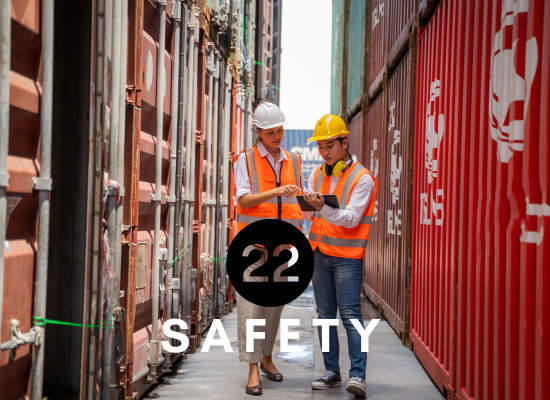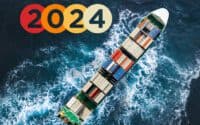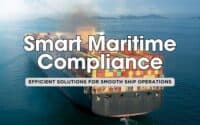Top 22 Safety Enhancements for Maritime Leaders in 2024

Maritime ship owners are undoubtedly familiar with the importance of safety and efficiency in their operations. Many of you have likely implemented various safety measures and are experiencing the benefits of these initiatives. However, as technology evolves and new challenges arise, there is always room for improvement. In this article, we’ll explore a range of innovative safety strategies designed to further enhance your operations. While some of these ideas may already be part of your safety protocols, we believe you will find new and valuable approaches that you haven’t considered before, all aimed at improving safety, reducing risks, and ensuring compliance in the increasingly complex maritime environment of 2024.
* Please send feedback/suggestions to editor @ shipuniverse.com
1. Implement Augmented Reality (AR) Training Simulations:
Description: Augmented Reality is transforming how crew members are trained by simulating real-life scenarios onboard without any associated risks. AR can visually demonstrate emergency procedures and equipment operations, ensuring that the crew is well-prepared to handle various situations. It’s a dynamic shift from traditional training, providing interactive and immersive learning experiences that stick.
Cost: Initial setup costs can be high due to the need for AR hardware and software development but can reduce training costs in the long run by minimizing the need for physical resources and location-based training.
Implementation: Begin with a pilot program focusing on high-risk scenarios. Gradually expand as you evaluate effectiveness and return on investment.
2. Advanced Analytics for Predictive Maintenance:
Description: Embrace advanced analytics to predict and prevent equipment failure before it happens. Utilizing data collected from sensors across the ship, predictive models can forecast potential breakdowns, allowing for timely maintenance that minimizes downtime and prevents accidents. This proactive approach is not just about fixing what’s broken but ensuring that it doesn’t break in the first place.
Cost: Moderate to high investment in sensor technology and analytics software, offset by the potential reduction in unscheduled repairs and downtime.
Implementation: Start by installing sensors on critical equipment and use existing data to develop baseline predictive models. Scale up based on initial successes.
3. Enhanced Fatigue Monitoring Systems:
Description: Crew fatigue is a significant risk factor in maritime accidents. Implementing wearable technology that monitors vitals and tracks sleep patterns can help predict and manage fatigue among crew members. These systems alert when rest is needed, ensuring that everyone on board is operating at peak alertness, particularly during critical operations.
Cost: Initial costs for wearables are generally low to moderate, with ongoing costs for software maintenance and data analysis.
Implementation: Equip crew with wearables during a trial phase to gather data on its impact on crew performance and safety outcomes. Integrate feedback to optimize the system.
4. Utilize Drones for Inspection and Surveillance:
Description: Drones provide a pair of eyes in the sky and can be used to inspect hard-to-reach areas of a ship, such as the cargo holds, ballast tanks, and exterior hulls while at sea. This not only reduces the risk associated with manual inspections but also enhances the thoroughness of regular safety checks. Drone footage can be analyzed in real-time to spot issues before they escalate into serious problems.
Cost: Moderate for drone equipment and training, potentially high if opting for advanced models with superior imaging capabilities.
Implementation: Start with drones capable of basic visual inspections to establish operational protocols and safety procedures, then consider more sophisticated drones with additional sensing capabilities as you scale.
5. Cybersecurity Enhancements for Ship Systems:
Description: As ships become more connected, the risk of cyber-attacks increases. Implementing robust cybersecurity measures to protect navigation and communication systems is crucial. Regular security audits, crew training in cyber hygiene, and advanced encryption can prevent unauthorized access and data breaches.
Cost: Investment depends on the current state of IT infrastructure, but generally involves moderate to high costs for software security, professional services, and training.
Implementation: Begin with an assessment of existing vulnerabilities, followed by the deployment of security updates and protocols. Continuously educate crew members on cybersecurity best practices and establish routine checks.
6. Real-Time Health Monitoring in Harsh Environments:
Description: Implement health monitoring systems capable of functioning in the harsh maritime environment to ensure crew health is maintained. These systems should monitor environmental factors such as air quality and temperature, as well as medical conditions that could be exacerbated by them.
Cost: Costs can vary but are generally moderate, involving investment in environmental sensors and health monitoring equipment.
Implementation: Start by identifying the most critical environmental factors affecting crew health aboard your vessels. Install sensors and health monitors, integrate them with the ship’s existing health safety protocols, and train crew on how to respond to alerts.
7. Integration of Virtual Reality (VR) in Emergency Drills:
Description: Virtual Reality can simulate complex emergency scenarios without actual risks, such as fires or severe weather conditions. VR drills can train crew members more effectively, ensuring they are prepared for real-life emergencies with practiced responses.
Cost: Initial costs for VR equipment and software development are high, but reduce costs associated with conducting live drills which often involve operational downtime and resource use.
Implementation: Pilot VR-based training programs with specific emergency scenarios relevant to the ship’s operations. Evaluate effectiveness and refine training modules based on crew feedback and performance metrics.
8. Advanced Fire Detection and Suppression Systems:
Description: Upgrade fire safety systems with the latest technology in fire detection and suppression. This includes smoke detectors that can differentiate between types of smoke, and automated suppression systems that can localize and extinguish fires without human intervention.
Cost: Installation of these advanced systems involves a high initial investment but can significantly reduce the risk of major fire damage and associated costs.
Implementation: Assess the current fire safety systems onboard, identify areas for improvement, and gradually retrofit ships with advanced systems. Train crew on the operation of new systems and conduct regular maintenance checks.
9. Smart Wearables for Man Overboard Prevention:
Description: Equip crew members with smart wearables that can detect a man overboard incident immediately and alert the vessel’s navigation and rescue teams. These devices use GPS and sensors to provide precise location data, speeding up rescue operations.
Cost: The cost is relatively moderate, depending on the sophistication of the technology. Bulk purchasing and integration with existing safety systems can reduce per-unit costs.
Implementation: Start with a trial on one vessel to gauge the effectiveness of the wearables. Following successful trials, roll out across the fleet and integrate with onboard safety and communication systems.
10. Eco-Friendly Anti-Fouling Technologies:
Description: Utilize the latest developments in eco-friendly anti-fouling technologies to not only protect the marine environment but also improve vessel performance and safety. These technologies prevent the accumulation of marine organisms on the hull, which can degrade vessel integrity and efficiency.
Cost: Initial application costs are higher than traditional coatings but offer long-term savings through reduced maintenance and fuel consumption.
Implementation: Retrofit a small number of ships initially to monitor performance improvements and environmental impact. Expand usage based on results and regulatory compliance benefits.
11. Dynamic Positioning Systems for Safer Docking and Anchoring:
Description: Implement dynamic positioning systems to enhance the precision of docking and anchoring operations, particularly in challenging conditions. These systems use advanced algorithms and thrusters to maintain a vessel’s position automatically.
Cost: High initial investment in technology and training but can prevent costly accidents and reduce fuel consumption by optimizing operations.
Implementation: Equip ships that operate in environmentally sensitive or geographically challenging areas first. Conduct comprehensive crew training to ensure effective use of the technology.
12. Collision Avoidance Systems with AI Integration:
Description: Integrate AI-driven collision avoidance systems that can predict and maneuver away from potential collisions autonomously. These systems analyze data from radar, AIS, and visual feeds to make quick decisions that enhance navigational safety.
Cost: High due to the need for sophisticated software and hardware, but potentially offset by reducing the risk of costly accidents.
Implementation: Begin with an AI pilot program on vessels that frequently navigate busy shipping lanes. Monitor system performance and crew adaptation before expanding to the rest of the fleet.
13. Satellite-Based Internet for Enhanced Communication:
Description: Install satellite-based internet systems to ensure reliable, high-speed communication from any location on the globe. This upgrade not only improves the ability to communicate in emergencies but also supports the real-time transfer of data for navigation and weather forecasting.
Cost: High initial setup and subscription costs, but the investment ensures constant connectivity which is crucial for safety and operational efficiency.
Implementation: Start with upgrading communication systems on ships that operate in remote areas. Evaluate the impact on emergency response times and operational efficiency to justify further investment across the fleet.
14. Modular Safety Training Programs Customized by Ship Type:
Description: Develop and implement modular safety training programs tailored to the specific needs and risks associated with different types of ships in your fleet. This approach ensures that training is relevant and practical, addressing the unique challenges faced by each vessel type.
Cost: Moderate development costs, with ongoing expenses for training delivery and updates. Cost-effective in the long term by reducing accident rates and improving compliance with safety regulations.
Implementation: Identify the unique requirements and risks for each ship type, develop specialized modules, and roll out training in phases, starting with the highest-risk vessels.
15. Automated Emergency Response Systems:
Description: Implement automated systems that can take immediate action in emergencies, such as deploying lifeboats, sealing off fire zones, or managing ballast to stabilize the ship. These systems react faster than humans, potentially saving lives and preventing further damage.
Cost: High due to the need for advanced technology integration into existing ship systems, but potentially invaluable in preventing major accidents.
Implementation: Retrofit key ships with these systems as part of a phased safety upgrade program. Conduct extensive drills to ensure that automated systems integrate seamlessly with manual emergency protocols.
16. Enhanced Hull Monitoring Sensors:
Description: Equip ships with sensors embedded in the hull that monitor its integrity in real-time. These sensors can detect cracks, corrosion, or other structural weaknesses that could lead to accidents, providing alerts for preventive maintenance.
Cost: Initial installation is moderately expensive, but maintenance and monitoring costs are low. The investment can prevent more costly repairs and accidents caused by structural failures.
Implementation: Pilot the technology on older ships that might be more prone to structural issues. If effective, expand to the entire fleet, integrating sensor data with the ships’ central maintenance systems for ongoing monitoring and analysis.
17. Enhanced Weather Tracking Systems:
Description: Integrate enhanced weather tracking systems that provide real-time, accurate meteorological data directly to the bridge. This enables better decision-making for route planning and storm avoidance, crucial for preventing weather-related incidents at sea.
Cost: Moderate to high, depending on the sophistication of the systems chosen. Costs are justified by the potential to avoid severe weather damage and ensure safer voyages.
Implementation: Install state-of-the-art weather monitoring equipment on a few ships initially to evaluate its effectiveness. If proven beneficial, gradually equip the entire fleet and train crews in using these systems to make informed navigational decisions.
18. Strengthened Ship-to-Shore Communication Protocols:
Description: Develop and enforce strengthened communication protocols between ships and shore-based operations. This includes regular scheduled check-ins and the use of encrypted communication channels to ensure clear, secure transmissions, crucial for maintaining safety in critical situations.
Cost: Low to moderate, primarily involving the upgrade of communication equipment and security software.
Implementation: Update communication protocols and systems, and conduct training sessions with both ship-based and shore-based personnel to ensure seamless implementation of these new protocols.
19. Comprehensive Safety Audits and Feedback Loops:
Description: Implement a structured program of comprehensive safety audits combined with feedback loops that allow for continuous improvement. This includes regular inspections, accident investigation follow-ups, and crew feedback mechanisms to identify and mitigate risks more effectively.
Cost: Moderate, due to the need for trained audit personnel and systems to manage feedback and follow-up actions.
Implementation: Begin with an annual audit of select ships, expanding to semi-annual audits fleet-wide as processes are refined. Encourage crew participation by integrating feedback tools into daily operations.
20. Advanced Training for Crisis Management:
Description: Provide advanced training programs in crisis management, including simulation of extreme situations that crew might face, such as piracy attacks, extreme weather, and onboard fires. This training helps improve readiness and response strategies under stress.
Cost: High, due to the need for specialized trainers and equipment to simulate realistic scenarios.
Implementation: Start with command-level officers and critical roles, expanding to include all hands. Use feedback from initial training sessions to adjust scenarios and improve the curriculum.
21. Biometric Access Control Systems:
Description: Implement biometric access control systems onboard to enhance security. These systems use fingerprint or facial recognition to restrict access to sensitive areas such as the engine room, navigation bridge, and control systems, ensuring that only authorized personnel can enter these critical spaces.
Cost: Moderate to high, depending on the level of technology adopted. The cost is offset by the significant increase in security and prevention of unauthorized access.
Implementation: Start by integrating biometric systems in one vessel to monitor effectiveness. Following a successful pilot, gradually install in other ships, training all crew members on the new security protocols.
22. Eco-Safe Contingency Planning:
Description: Develop contingency plans that not only address safety and emergency responses but also incorporate eco-safe practices. This includes protocols for handling fuel spills, hazardous materials, and wildlife encounters in a way that minimizes environmental impact while ensuring crew and vessel safety. Cost: Low to moderate, primarily involves the development and documentation of procedures and training.
Implementation: Collaborate with environmental experts to create guidelines tailored to the typical routes and cargo of your fleet. Conduct training workshops to familiarize the crew with these new procedures, followed by regular drills to ensure readiness.
The strategies outlined above represent the cutting edge of safety technology and practices, tailored for maritime operations as we move into 2024 and beyond. Whether it’s enhancing communication with satellite-based systems, adopting advanced crisis management training, or implementing eco-friendly safety measures, each strategy offers a unique opportunity to not only comply with international safety standards but also to lead in the stewardship of global maritime safety. As you evaluate these strategies, consider the specific needs and contexts of your fleet to choose the most effective implementations. Embracing these advancements will not only safeguard your operations but also position your fleet as a leader in maritime safety innovation.

Do you have a Maritime Product or Service that may be of interest to Shipowners? Tell us about it here!
Do you have feedback or insights? Please reach out to editor @ shipuniverse.com



